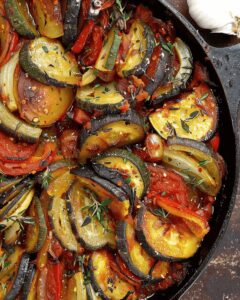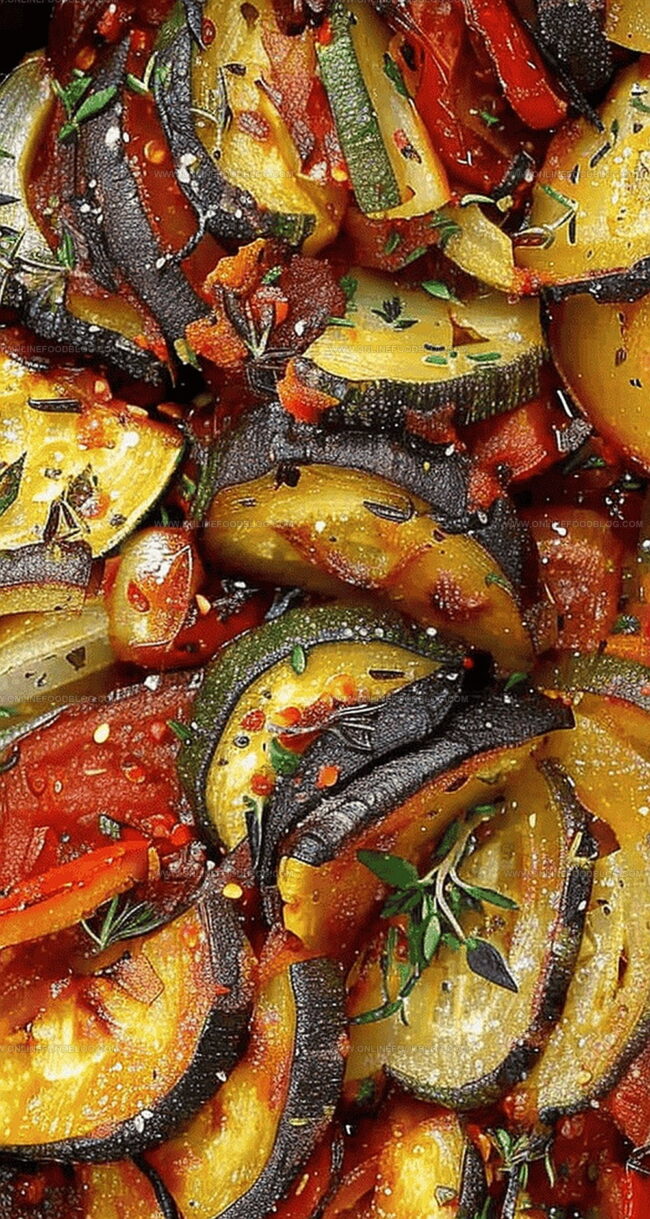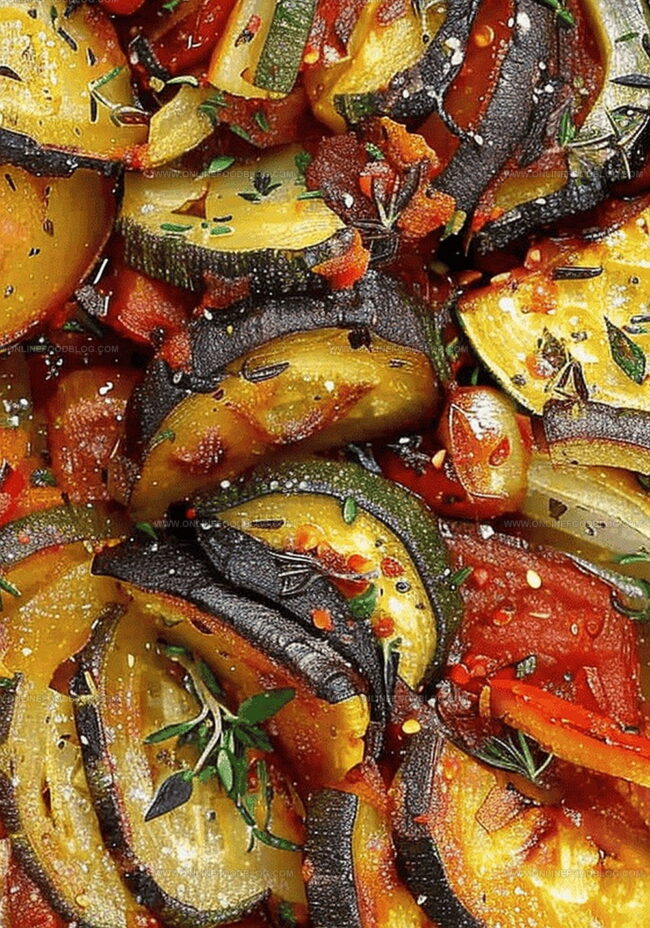Zesty Briam: Rustic Greek Roasted Vegetables Recipe
Summer’s golden rays dance across the Mediterranean, casting warmth on a classic briam that celebrates fresh, vibrant produce.
Greek kitchens buzz with the aroma of slowly roasting vegetables infused with olive oil and herbs.
This traditional Greek roasted vegetables recipe captures the essence of rustic, simple cooking that connects generations.
Layers of zucchini, potatoes, tomatoes, and onions meld together in a harmonious blend of flavors and textures.
Each bite tells a story of sun-drenched gardens and time-honored culinary traditions.
The dish sings with the richness of extra virgin olive oil and the depth of Mediterranean seasonings.
Dive into this delectable recipe and let your taste buds travel to the heart of Greece.
Quick Recipe Overview
Ingredients for Briam: Traditional Greek Roasted Vegetables
For Fresh Vegetables:For Aromatic Enhancers:For Liquid and Seasoning Components:Prep Tools for Traditional Greek Briam
How to Roast Briam Vegetables the Greek Way
Slice potatoes, zucchini, and onions with care. Create thin, even pieces that will roast beautifully and absorb all the delicious Mediterranean flavors.
Sprinkle herbs and spices generously over the sliced vegetables. Let oregano, rosemary, and garlic dance together, creating an aromatic blend that captures the essence of Greek cuisine.
Arrange vegetables in a circular pattern inside an oven-safe pan. Create a beautiful mosaic of colors and textures, alternating between potatoes, zucchini, and onions.
Spread diced tomatoes across the bottom and top of the vegetable layers. These juicy tomatoes will infuse the dish with rich, tangy goodness and help create a moist cooking environment.
Drizzle extra virgin olive oil generously over the vegetables. This liquid gold will help vegetables caramelize and develop deep, complex flavors during roasting.
Bake covered for 45 minutes, then uncovered for an additional 30-40 minutes. Watch as the vegetables turn golden, slightly crisp, and develop a beautiful rustic character.
Remove from oven and let the briam rest. Serve warm, allowing the vegetables to showcase their tender texture and concentrated flavors, embodying the soul of Greek home cooking.
Ideas to Adjust the Spice and Veggie Mix
Serving Briam with Bread or Rice
Refrigeration Tips for Briam That Lasts
Print
Rustic Briam
- Total Time: 1 hour 35 minutes
- Yield: 5 1x
Description
Greek briam showcases Mediterranean vegetable roasting at its finest. Hearty root vegetables and zucchini mingle with olive oil, herbs, and tomatoes, offering home cooks a simple yet deeply satisfying dish you’ll want to savor slowly.
Ingredients
- 1 ¼ lbs / 570 g gold potatoes (about 3 medium-size potatoes), peeled and thinly sliced into rounds
- 1 ¼ lbs / 570 g zucchini squash (2 to 3 zucchini), thinly sliced into rounds
- 1 large red onion or 2 smaller red onions, thinly sliced into rounds
- 1 can (28 oz / 794 g) diced tomatoes with juice
- ½ cup / 35 g chopped fresh parsley
- 4 garlic cloves, minced
- 2 tsps / 3.6 g dried oregano
- 1 tsp / 1.2 g dried rosemary
- Salt and pepper
- Early Harvest Greek extra virgin olive oil
Instructions
- Preparation: Calibrate oven to 400°F with rack positioned centrally for uniform heating.
- Vegetable Seasoning: Blend sliced potatoes, zucchini, and onions with oregano, rosemary, parsley, and garlic, thoroughly massaging each slice with extra virgin olive oil, salt, and pepper to ensure comprehensive flavor absorption.
- Pan Layering: Create a foundational tomato base in a large oven-safe pan, then meticulously arrange seasoned vegetables in an alternating, visually striking circular pattern to maximize flavor integration and aesthetic appeal.
- Initial Roasting: Cover pan with aluminum foil, allowing gentle steaming for 45 minutes, enabling ingredients to soften and harmonize their distinctive flavors without direct heat exposure.
- Caramelization: Remove foil and return pan to oven, allowing vegetables to develop rich, golden-brown edges and concentrate their natural sweetness for an additional 30-40 minutes.
- Finishing Touch: Confirm vegetable tenderness and reduced liquid consistency, then embellish with a final drizzle of extra virgin olive oil, serving either warmly or at room temperature to highlight the dish’s rustic Greek culinary essence.
Notes
- Vegetable Slicing Technique: Cut vegetables uniformly thick to guarantee even cooking and consistent texture throughout the dish.
- Oil Coating Strategy: Thoroughly massage vegetables with olive oil, ensuring each piece is richly coated for maximum flavor absorption and caramelization.
- Layering Importance: Arrange vegetables in artistic circular patterns to create visual appeal and promote balanced heat distribution during roasting.
- Foil Tenting Tip: Cover pan loosely with aluminum foil without touching vegetables, allowing steam to circulate while preventing excessive browning during initial cooking phase.
- Prep Time: 20 minutes
- Cook Time: 1 hour 15 minutes
- Category: Lunch, Dinner, Snacks
- Method: Roasting
- Cuisine: Greek
Nutrition
- Serving Size: 5
- Calories: 130
- Sugar: 4 g
- Sodium: 250 mg
- Fat: 7 g
- Saturated Fat: 1 g
- Unsaturated Fat: 6 g
- Trans Fat: 0 g
- Carbohydrates: 18 g
- Fiber: 3 g
- Protein: 3 g
- Cholesterol: 0 mg




Mia Reynolds
Food Writer & Home Cooking Specialist
Expertise
Easy Home Baking, Recipe Writing and Storytelling, Local and Seasonal Ingredients, Baking for Beginners
Education
New England Culinary Institute (NECI), Montpelier, Vermont
Community College of Vermont, Winooski, Vermont
Mia Reynolds fell in love with baking as a teenager experimenting in her family kitchen. Her passion took her to New England Culinary Institute, where she learned practical pastry techniques, and later to Community College of Vermont to deepen her understanding of food management.
Mia combines clear, simple baking instructions with heartwarming stories, making home baking approachable for everyone.